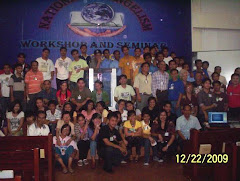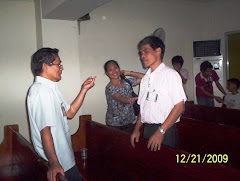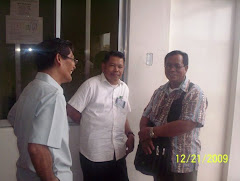
A hodgepodge of factors came into play in God’s purpose to establish a congregation of His people in Dasmariñas, in the province of Cavite. Call it divine providence with God controlling events to achieve His design. Call it serendipity for the excitement it offers to its beholders.
Many factors. Mention for example the literature sent by the president of a Bible college in Baguio, which sparked religious curiosity. Mention a young OFW named Geminiano Mendoza whose contact with a restoration church in Guam and some A. G. Hobbs tracts he had brought home motivated the desire of the Javier-Sico clan, consisting of sister Resurreccion Javier-Hembrador, sister Gloria Javier-Sico and her husband Jacinto Sico, and the Silvas, the Guevaras, the De Mesas, the Mangubats and the Mendozas to find the ancient roots of the true faith, and their decision to break away from the Disciples of Christ, a faith which they for a while had held so dear, then their insistence for a thus-saith-the Lord as a reason for every doctrine and practice when their new found faith was questioned and challenged. That’s providence of God that offered man the joys of discovering what’s true and what’s approved. But we are getting ahead of the story.
The story of the founding of the Lord’s church in Dasmariñas must begin with Corporal Luis Javier, ancestor of the Javier-Sico clan whose number predominates the membership of this congregation, one of whose descendants, Nepthalie Javier Sico, is now the minister of this church. For it was on his plot of land in the village of San Jose, close to the town of Dasmariñas, that the present chapel of Dasmariñas church of Christ now stands.
The Tagalog province of Cavite was the heartland of later Philippine revolution. Concerning that revolution, recall that Gen. Emilio Aguinaldo was its leader, and was also the first president of the short-lived republic that came after it. Recall that not too far away from Dasma is Imus, the seat of this republic. In this forsaken land of a people who rebelled against mother Spain, God the Father of all mankind carved out a congregation of men and women who obeyed His will, the first church of Christ in all of Southern Tagalog region.
Luis Javier, whose corporal rank he got as a Katipunero while engaged in the 1898 Revolution, found employment as a blacksmith in the American Naval Base in Sangley Point, in a thankless job where he often clashed with his Yankee boss. But he embraced the Presbyterian faith the Americans brought to our shores.
That Presbyterian faith was not to remain. In those days, his fluency in Spanish and his flair for oratory made him a stage figure, haranguing the Hare-Hawes-Cutting Act, introducing political candidates on stage, campaigning and crusading for a cause, speaking in Presbyterian meetings, but more especially defending the Presbyterian faith in debates. In one of his discussions he lost to a Disciples of Christ debater. Debates in those days were much like wars of conquests: The defeated became the spoils of war. So Corporal Luis Javier left the Presbyterians and became a Disciples member; more so, he became a Disciples debater and proclaimer of their gospel. He loved his new found faith he supported it, defended it, and walked kilometers of distances from the barrio of Dasmariñas where he lived to surrounding villages of Malagasang and San Francisco de Malabon (now Gen. Trias) to plead its cause. He was the principal mover and one of those who started the Malagasang Disciples church. In those days, Malagasang, like Dasma, was a barrio of Imus.
All three of Corporal Luis Javier’s children—Juan, Resurreccion and Gloria—became Disciples. Brother Nephtalie Sico, the present minister of Dasma church, remembers attending with his siblings the Sunday school taught by Malagasang Disciples lady teachers.
Juan, the only son of Corporal Luis Javier, migrated to Olongapo, started a family, and raised his sons and daughters as Disciples. In one instance, he attended a religious meeting in Bajac-Bajac and got into contact with a Church of Christ missionary. The missionary promised to send him a tract that perhaps was to change his life and his religion, if he provided them his address; instead he gave them the address of his sister Gloria Javier-Sico, now married to Jacinto Sico, who lived with another sister, Resurreccion, in Dasma. Months later, sister Gloria Javier-Sico received a New Testament Christianity magazine from Ralph Brashears, director of Philippine Bible College-Baguio City. That tract was to arouse their curiosity in religion.
Corporal Luis Javier remained a Disciples of Christ member until he died, and never saw the changes that were to happen in the Philippines religious landscape. The Malagasang Disciples church ceased to be because it was absorbed in the religious umbrella called the United Church of Christ in the Philippines. Juan Javier never left the Disciples.
A young Disciple named Geminiano Mendoza was to bring to fruition the seed that had been planted. Working in Guam, he gravitated to the Church of Christ group, became interested in their teachings and brought home some tracts of brother A. G. Hobbs. Two of those tracts, titled “The Origin of Denominations” and “Safe or Sorry,” helped to turn the Dasma Disciples, consisting of the Sicos, the Silvas, the Mangubats, the Mendozas, the De Mesas and the Guevaras around. Joined by Isabelo Hayuhay and another Disciple minister, they cast their lot with the Church of Christ.
An interesting twist of history happened in the course of their journey. Isabelo Hayuhay later associated with the anti-Bible College, anti-benevolence segment of the Restoration Movement. The Dasmariñas disciples, now consisting of believers whom Jimmy Mendoza had helped to usher into the kingdom, came to be nurtured by the workers from the Pi y Margal branch of Philippine Bible College, most especially by brother Paulino Garlitos. American missionaries—Bob Buchanan, Ken Wilkey, Charles Smith, Ray Bryan, Douglas LeCroy, Bill Cunningham— came and helped edify the new church.
Neph J. Sico, grandson of Luis Javier, finished his degree at PBC-Baguio in 1974 and became the minister of Dasma church. Other youths from Dasma followed him—Loida Sico, Willie Mendoza, Joel Sico, Olly Silva, Raquel Sico, Jeffrey Sico, and Ramir De Mesa.
Dasma church has now become the home of the Church Planting Institute (CPI). A new building of CPI, donated by brother Rolly Abaga, has risen beside the Dasma meeting hall. CPI has 9 students. Its teachers include Neph Sico, Jun Patricio, Rolly Abaga, Jonathan Pagarao, Jun Michael Pague, Gerry Superiano and Moises Gonzales.



































No comments:
Post a Comment